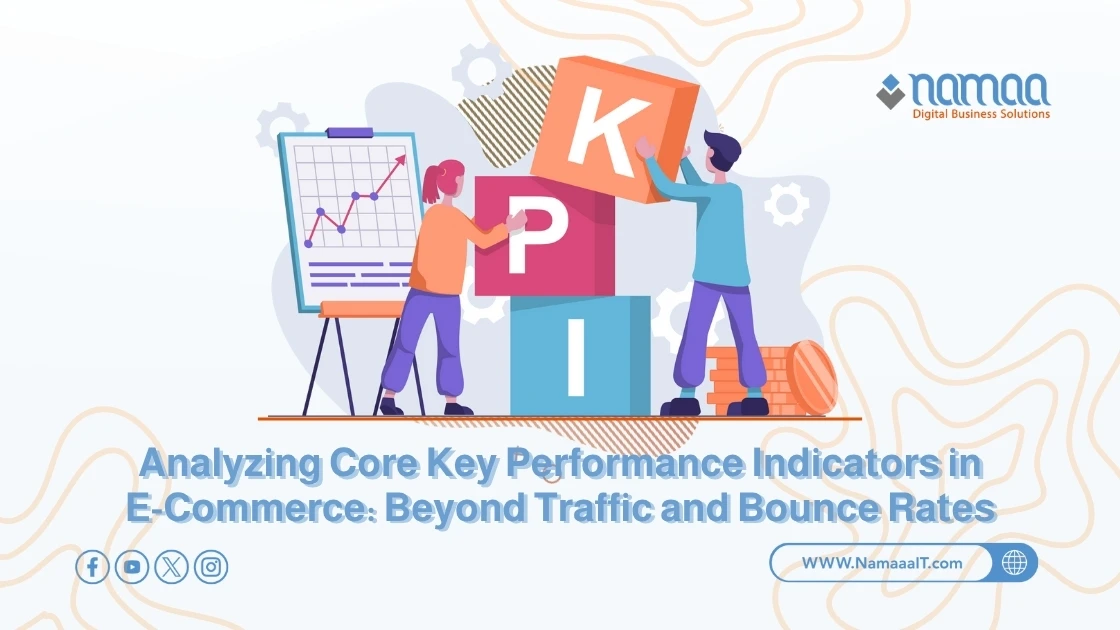In the world of e-commerce, it’s not enough to see the visitor counter rise or celebrate a lower bounce rate. These numbers might look good on paper, but they often don’t reflect the full picture of your store’s performance or the effectiveness of your strategy. The performance indicators that matter in e-commerce are the ones directly tied to revenue, customer loyalty, and user experience. In this article, we uncover the metrics that truly make a difference and explain how ignoring superficial indicators and focusing on what matters can transform your business from just activity to real growth.
What Are Key Performance Indicators (KPIs) in E-commerce?
Key Performance Indicators, or KPIs, are digital measurement tools used to assess how successful a business is in achieving its strategic goals. In e-commerce, their importance is magnified because they are the language through which we interpret the performance of a digital store. KPIs are not just numbers displayed in reports, but an integrated system to interpret reality and monitor progress or setbacks at every stage of the business.
In a rapidly changing and data-driven world, no online business can thrive or grow without clearly defining its goals and how success will be measured. KPIs serve as a way to translate broad goals into measurable reference points. Whether the goal is to increase sales, improve user experience, or reduce costs, there are always specific KPIs to track whether you’re on the right path.
KPIs stand out because they don't rely solely on quantity—they tie the numbers to context. Unlike general statistics, KPIs are designed to serve a clear purpose and are carefully selected to align with the store’s nature, business model, and target audience. They also act as a common language between different teams in a digital project, helping everyone understand performance and prioritize improvements.
Why Visits and Bounce Rates Alone Aren’t Enough to Measure Success
It’s easy to be impressed by website visit numbers or low bounce rates, but these are superficial indicators that may give a misleading impression of your online store’s performance. Many digital business owners fall into the trap of focusing on metrics that look good rather than those that reflect real results. A visit doesn’t always mean purchase intent, and bounce rate doesn’t always reveal customer satisfaction or dissatisfaction. Therefore, relying solely on these metrics won’t give you a clear picture of profitability or growth.
For example, you could receive thousands of daily visits from paid ads but make no notable sales because the visitors are not targeted or the user experience doesn't encourage them to complete the purchase. Similarly, a low bounce rate might be due to curiosity-driven navigation, not actual buying intent. On the other hand, you could have a low number of visits but a high conversion rate, which means your audience is effectively targeted.
The real success indicators are those linked to customer behavior—such as the time spent on a product page, the number of clicks on the “Add to Cart” button, and the number of completed orders. These metrics reflect actual intent and provide actionable insights to improve performance. Success in e-commerce isn’t measured by movement but by outcomes. It’s time to move beyond vanity metrics and focus on those that reveal whether your store is delivering real value to customers.
Discover: The Global Expansion of E-commerce
The Top 10 KPIs You Should Track for Your Online Store
To succeed in the e-commerce market, it’s not enough to launch your store and wait for results. You need to monitor the numbers that tell you what’s really going on. Here are 10 key KPIs that deserve your full attention:
- Conversion Rate: Measures the percentage of visitors who become actual customers; a direct indicator of the quality of the buying experience.
- Average Order Value (AOV): The higher it is, the more profit you make without needing to attract more customers.
- Cart Abandonment Rate: Indicates issues with pricing, shipping, or the checkout experience.
- Customer Acquisition Cost (CAC): Tells you how much you’re spending to turn a visitor into a customer; compare it to how much they spend.
- Customer Lifetime Value (CLV): Reveals how profitable a customer is over the long term.
- Repeat Customer Rate: A high rate means loyalty and trust—more valuable than any ad campaign.
- Bounce Rate: A high rate suggests a gap in your content or page experience.
- Session Duration and Pages per Visit: Show how engaged users are with your site.
- Click-Through Rate (CTR): Measures the effectiveness of your ad campaigns and product titles.
- Complaint or Return Rate: A sensitive indicator of product quality and post-sale experience.
Regularly tracking these KPIs helps you make informed decisions, improve marketing strategies, and get the most return from every dollar you invest. Don’t leave success to chance—let the numbers guide you.
How to Analyze KPIs to Improve Your Digital Marketing Strategy
Analyzing KPIs in e-commerce isn’t just about knowing what happened—it’s about understanding why it happened and how to improve. This is at the heart of smart marketing decisions. Once the data is collected, the real task begins: turning numbers into actionable insights. This is what sets apart random KPI monitoring from strategic decision-making.
Start by categorizing KPIs based on the customer journey stages: awareness, engagement, conversion, and loyalty. For example, if you notice a drop in CTR (Click-Through Rate), you might need to revise your ad messaging or test new designs. If your cart abandonment rate is high, the problem might be with shipping or a complex checkout process. If the average order value is low, try offering smart product recommendations or bundle discounts.
Next comes hypothesis testing through A/B Testing, which involves testing two versions of an element (like a page, ad, or email) to see which performs better. Also, use advanced analytics tools like Google Analytics and Hotjar to understand user behavior through heatmaps and session recordings.
A strong marketing strategy isn’t based on gut feelings or guesswork, but on a precise reading of e-commerce KPIs. Every improvement backed by real data brings you closer to your target audience and increases your chances of conversion and profit. The equation is simple: Better analysis = Smarter decisions = Stronger results.
Discover: How to Improve Page Loading Speed
read more: Data-Driven Product Launch Plan for E-commerce Stores
Tools for Analyzing E-commerce KPIs
To analyze KPIs effectively in e-commerce, you need specialized tools that don’t just collect data, but help you interpret it and turn it into actionable decisions. Among the most important tools is Google Analytics 4 (GA4), the cornerstone of user behavior analysis. GA4 provides detailed data on traffic sources, top-performing pages, conversion paths, and ad campaign performance, and allows you to customize reports to match your store's nature.
In addition to GA4, tools like Hotjar and Microsoft Clarity let you track visual user interaction through heatmaps and session recordings. These tools show where users click, where they stop, and where they lose interest—helping you improve the user experience.
For deep analysis of buying behavior, tools like Shopify Analytics (if you use Shopify) or WooCommerce Reports offer customized insights on sales, top products, and return rates.
If you run digital ad campaigns, platforms like Google Ads Dashboard and Meta Business Suite are essential to monitor CTR, cost per conversion, and ad ROI. You’re also advised to integrate all tools into a single dashboard using services like Google Looker Studio or Klipfolio, giving you a unified, comprehensive view.
How to Choose the Right KPIs for Your Store
Choosing the right KPIs is not a default step—it depends on the type of products you sell, your sales cycle, customer behavior, and your business model. A store selling fast-moving consumer goods like cosmetics will track different KPIs than one selling high-end electronics or subscription services. That’s why it’s crucial to understand your business deeply.
Start by defining your core goals: Do you want to increase the number of orders? Increase average order value? Retain existing customers? Each goal requires different KPIs. For example, if your goal is to build customer loyalty, track repeat purchase rate and CLV. If you’re launching a new product, prioritize reach and conversion from new visitors.
Likewise, your audience type affects your KPI selection. Stores targeting quick decision-makers (like Instagram or TikTok users) should focus on conversion speed, while those targeting more analytical audiences (like businesses or professionals) should track session count before purchase and decision-making time.
Finally, don’t try to track every KPI at once. Focus on 3 to 5 key indicators for each growth stage and review them regularly. A good KPI isn’t the most popular—it’s the one most closely tied to your business goal and most capable of driving better decisions.
Frequently Asked Questions
Do KPIs differ between local and international stores?
Yes, international stores require additional KPIs like international shipping performance, multi-currency handling, and customer behavior by location. Local stores focus more on delivery speed and after-sales service quality.
What role do KPIs play in inventory management?
KPIs like inventory turnover and stockout rate help make accurate decisions about order quantities and timing, reducing waste and improving operational efficiency.
Can KPIs be used to assess customer service?
Absolutely. Track metrics like support response time, first-contact resolution rate, and customer satisfaction via post-purchase surveys or reviews.
What’s the relationship between KPIs and ad campaign evaluation?
Metrics like Return on Ad Spend (ROAS) and conversion rate from ads show each campaign’s effectiveness and help optimize targeting and pricing strategies.
Are KPIs important during the store launch phase?
Yes, the beginning is the best time to set clear KPIs. Even if sales are low, early behavior tracking helps identify obstacles and improve UX before scaling.
Conclusion
✅ KPIs are the foundation for understanding e-commerce success—not just random numbers. 73% of businesses that clearly define KPIs are more likely to reach their goals than those that don’t.
✅ Visits and bounce rates alone aren’t enough, as they don’t necessarily indicate purchase intent or customer satisfaction. Studies show 92% of online store visitors leave without buying, even if they visit multiple times.
✅ Key KPIs to monitor include: conversion rate, average order value, customer acquisition cost, and repeat purchase rate. Continuously improving these can increase sales by up to 40%.
✅ Tools like Google Analytics and Hotjar are essential—studies show businesses using advanced analytics tools improve their marketing productivity by 33%.
✅ KPI selection depends on your product type, audience, and business goals. For example, subscription businesses focus on CLV, while seasonal stores monitor peak demand and conversion speed.




.webp)
.webp)


